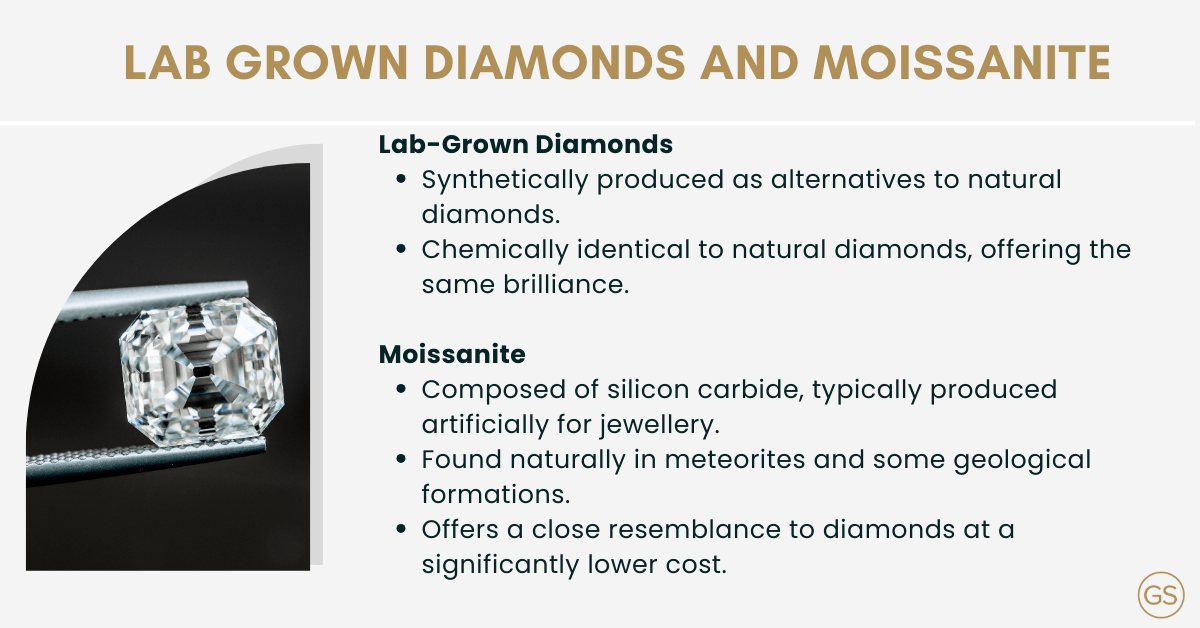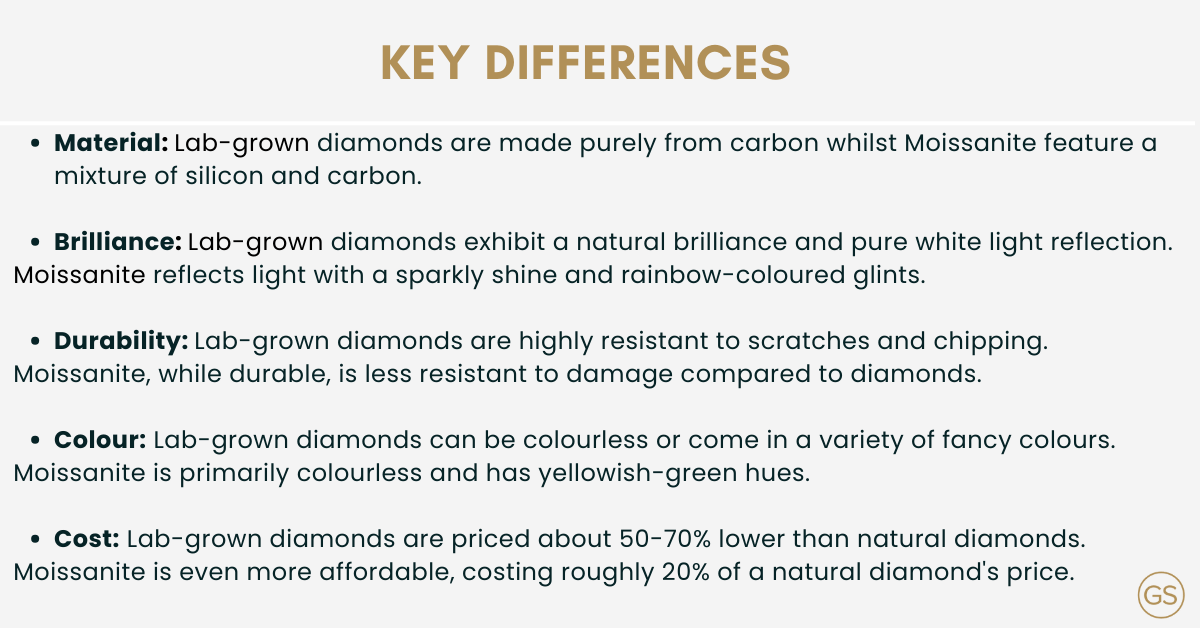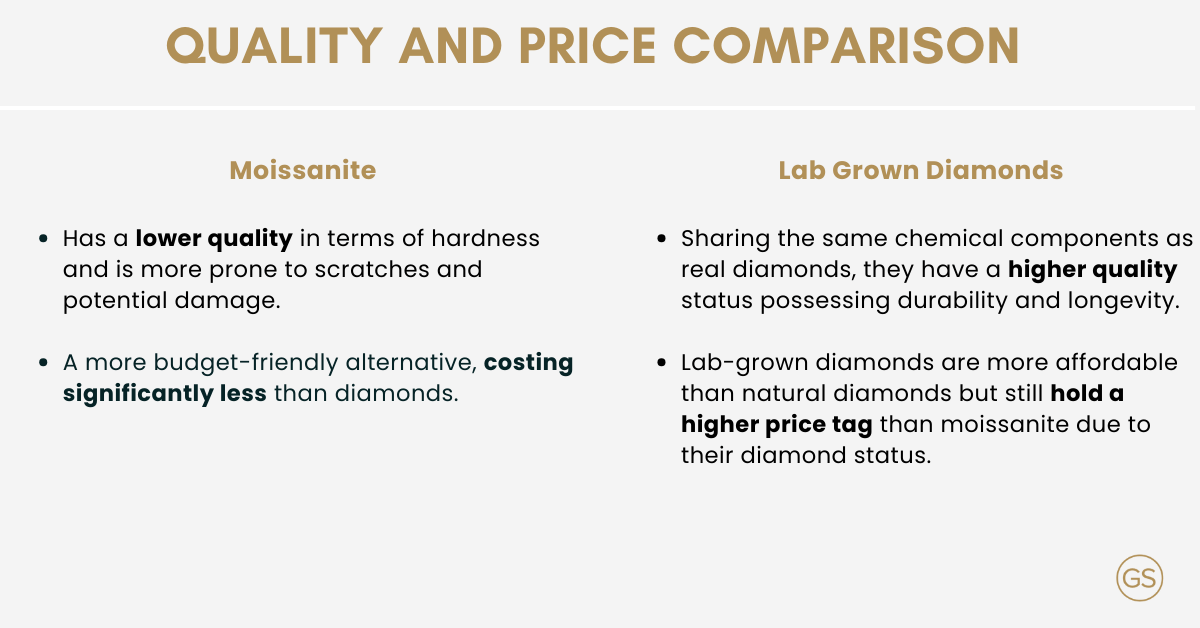
Lab diamonds or lab grown diamonds are one of the fastest growing segments in the jewellery industry. Spurred on by a seismic leap forward in market awareness, availability, and manufacturing efficiency over the past decade, more and more buyers are now considering whether they should opt for lab grown diamonds, or opt for traditional natural diamonds.
But when it comes to finding wallet-friendly natural diamond alternatives, lab grown diamonds are the new kids on the block. Back before lab grown vs. natural was even a question, moissanite was the budget-friendly option for many buyers.
Contrary to some of the information out there, moissanite and lab grown diamonds are not synonyms – they are vastly different. In this article, we’ll go through those key differences and help would-be buyers make an informed decision when weighing up lab created diamond vs moissanite.

Lab grown diamonds, also known as synthetic or cultured diamonds, are man-made alternatives to naturally mined diamonds. The big question that most diamond buyers have about lab grown diamonds is whether they are actually real diamonds. The answer is yes — lab grown diamonds are chemically identical to their natural counterparts, and boast the same dazzling brilliance diamond seekers have come to expect.
Moissanite is a gemstone composed of silicon carbide (a combination of silicon and carbon). It's a relatively rare mineral found naturally in meteorites and certain geological formations and is usually produced artificially for use in jewellery. Moissanite bears a striking resemblance to diamond gemstones and is known for being a significantly cheaper alternative.
While the two types of gemstones bear some similarities in terms of their appearance, their chemical makeup is vastly different. All diamonds, natural or lab-grown, are made purely from carbon. Moissanite, on the other hand, features a mixture of silicon and carbon, setting it apart as a completely different type of material.
The shine of a lab-grown diamond features a natural brilliance when reflecting light. Moissanite also reflects light well, but the way it does so is slightly different — it often takes on a more sparkly shine with rainbow-coloured glints instead of the pure white of diamonds.

The difference in chemical makeup leads to another stark difference between lab grown diamonds and moissanite — durability. The durability of a gemstone (its hardness), is a measure of its ability to withstand damage or deformations from accidental impacts or brushes with other hard surfaces. Diamonds are the hardest substance on earth and are extremely resistant to scratches or chipping. In comparison, moissanite is less durable.
Colourless diamonds are the classic appearance of lab grown diamond gems, but they can also come in a rainbow of fancy colours ranging from red to blue. Moissanite is much more limited in terms of colour, with colourless and yellowish-green hues to choose from.
Lab grown diamonds generally cost about 50-70% less than comparable natural diamonds, while moissanite can cost significantly less at just 20% of the cost of a comparable natural diamond.
When it comes to buying a gemstone, especially for an engagement or wedding ring, quality is one of the biggest considerations for buyers. The phrase “diamonds are forever” rings true for lab-grown diamonds despite their man-made origin; they are 100% real diamonds that can truly last a lifetime and beyond.
Moissanite gemstones have a lower level of quality, especially when it comes to hardness. The material itself is more susceptible to scratches and damage, and in some cases, may eventually need to be replaced after a long period of time.

Cost is another big factor when deciding between lab-grown diamonds and moissanite. While lab-grown diamonds often come at a lower price point compared to their mined counterparts, their inherent status as diamonds grants them a higher price value compared to moissanite.
Moissanite is widely considered to be the budget-friendly option for gemstone jewellery, costing just a fraction of the diamond price.
For comparison’s sake, here are some estimated prices for a 1-carat lab-grown diamond and a 1-carat moissanite with similar cut, colour, and clarity:
Both moissanite and lab-grown diamonds are viable gemstone alternatives that delight in different ways. Ultimately, the decision comes down to your personal preferences (or the preferences of your loved one!).
Moissanite is a good option if budget is your primary concern, but you should know that a moissanite gemstone will not pass off as a diamond due to the clear difference in its shine and durability. Lab-grown diamonds are the better investment in the long term as their classic brilliance and natural hardness guarantee their quality even after decades of wearing them.
At GS Diamonds, our diamond experts can help you find a lab-grown diamond that suits your budget and features unparalleled fire and brilliance. Whether you are looking for an engagement ring for your partner or a gift for your loved one, our expansive collective of lab-grown diamonds is sure to have the perfect gem!